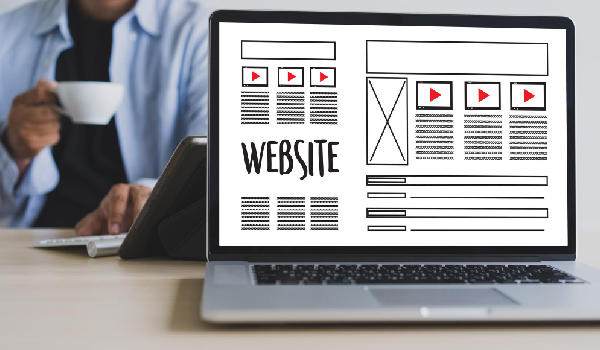Website Redesigning Cost India: How Much Does it Cost?
August 31, 2024 | Website Development
Are you not satisfied with your current website design or conversion rate even you are getting traffic? Today, we will discuss the website redesigning cost to learn how much you should estimate to pay to redesign a website in India.
Importance of Website Redesign

Redesigning a website is not merely about giving it a fresh look. It’s about enhancing its functionality, improving user experience, and staying current with technological advancements and market trends. Here are some key reasons why website redesign is crucial:
1. Improved User Experience (UX)
- Enhanced Navigation: Simplified and intuitive navigation helps users find information quickly and easily.
- Faster Load Times: Optimized website speed to reduce bounce rates and improve user satisfaction.
- Mobile Responsiveness: Ensuring the site works seamlessly across all devices, catering to the growing number of mobile users.
2. Updated Aesthetics
- Modern Look and Feel: Keeping the design up-to-date with current design trends to maintain a professional and appealing appearance.
- Brand Consistency: Aligning the website’s look with the company’s evolving brand identity and messaging.
3. Increased Conversion Rates
- Optimized Call-to-Action (CTA): Strategically placed and designed CTAs to drive more conversions.
- Streamlined Checkout Process: For e-commerce sites, simplifying the purchase process to reduce cart abandonment rates.
4. Better Search Engine Optimization (SEO)
- Updated Content: Fresh and relevant content can improve search engine rankings.
- SEO-friendly Design: Ensuring the site’s structure and design adhere to the latest SEO best practices.
5. Incorporation of New Technologies
- Integration of Modern Tools: Utilizing the latest web technologies and tools for enhanced functionality and performance.
- Security Enhancements: Updating security measures to protect against new vulnerabilities and threats.
6. Reflecting Business Changes
- Updated Offerings: Reflecting changes in products, services, and company direction.
- Scalability: Preparing the website to handle increased traffic and future business growth.
7. Competitive Advantage
- Staying Ahead of Competitors: A modern and well-functioning website can differentiate a business from its competitors.
- First Impressions: Creating a positive first impression to attract and retain customers.
8. Enhanced Analytics and Insights
- Improved Tracking: Better integration with analytics tools to gain deeper insights into user behavior and site performance.
- Data-Driven Decisions: Using analytics to make informed decisions about future improvements and marketing strategies.
9. Better Integration with Marketing Strategies
- Alignment with Campaigns: Ensuring the website supports and enhances digital marketing campaigns.
- Social Media Integration: Seamless integration with social media platforms for better engagement.
Investing in a website redesign can yield significant benefits, from improved user experience and higher conversion rates to better SEO and a competitive edge. It’s a strategic move that can drive growth and ensure a business remains relevant and effective in the digital landscape.
Encouraging a periodic review and update of the website ensures that it continues to meet the evolving needs of the business and its customers.
Consequences of Redesigning a Website?
Website redesign can have various consequences, both positive and negative, depending on how well it is planned, executed, and managed. Here are some common consequences of website redesign:
Positive Consequences
- Improved User Experience (UX):
- A well-executed redesign can enhance usability, navigation, and overall user experience, leading to increased user satisfaction and engagement.
- Enhanced Visual Appeal:
- Updating the design can modernize the look and feel of the website, aligning it with current design trends and improving brand perception.
- Increased Conversion Rates:
- Optimizing the user interface and implementing best practices in design and layout can lead to higher conversion rates, such as more sign-ups, purchases, or inquiries.
- Better SEO Performance:
- Redesigning with SEO best practices in mind, such as improving site speed, mobile-friendliness, and content optimization, can lead to better search engine rankings and organic traffic.
- Updated Technology and Features:
- Introducing new technologies, integrations, and features can enhance website functionality, scalability, and security, keeping it competitive in the digital landscape.
- Brand Reinforcement:
- A redesign can align the website with current branding strategies, reinforcing brand identity and messaging consistently across all digital channels.
Negative Consequences
- Temporary Drop in Traffic and Rankings:
- During and immediately after a redesign, there may be fluctuations in traffic and search engine rankings as search engines reindex the updated website and users adjust to the changes.
- Technical Issues and Bugs:
- Poorly executed redesigns can result in technical issues, broken links, or functionality errors, affecting user experience and SEO.
- Loss of User Familiarity:
- Users accustomed to the old design may find it challenging to navigate initially, leading to frustration and potentially higher bounce rates if the new design is not intuitive.
- Content and SEO Disruptions:
- Content restructuring or migration during a redesign can impact SEO if URL structures change or if meta tags and content optimization are not handled correctly.
- Cost Overruns:
- Unforeseen expenses, such as additional development time, extra features, or post-launch fixes, can lead to budget overruns if not properly managed.
- Negative Brand Perception:
- If the redesign does not align with user expectations or if there are significant usability issues, it could negatively impact brand trust and perception.
Mitigating Potential Issues

- Thorough Planning and Research: Conduct comprehensive planning, user research, and testing to anticipate and address potential issues before they arise.
- SEO and Content Strategy: Develop a solid SEO and content migration strategy to minimize disruptions and maintain or improve SEO performance.
- User Feedback and Testing: Gather feedback from users through usability testing and surveys to identify and address usability issues early in the redesign process.
- Communication and Training: Communicate with stakeholders, including employees and customers, about the upcoming changes and provide training or resources to help them adapt to the new website.
- Monitoring and Iteration: Monitor website performance post-launch, analyze metrics, and iterate based on user feedback to continuously improve the user experience and address any lingering issues.
By carefully planning and executing a website redesign while considering potential consequences, businesses can maximize the positive outcomes and mitigate risks, ensuring a successful transition to a new and improved website.
Why businesses in India are increasingly investing in website redesign?
Businesses are increasingly investing in website redesign for several compelling reasons, all of which align with their goals of enhancing user experience, staying competitive, and driving growth. Here’s an in-depth look at why this trend is gaining momentum:
- Enhanced User Experience (UX)
- Improved Navigation: Modern website designs focus on user-friendly interfaces, making it easier for visitors to find what they need quickly and efficiently.
- Mobile Responsiveness: With the rise in mobile device usage, businesses need websites that provide a seamless experience across all devices.
- Faster Load Times: A redesigned website can be optimized for speed, reducing bounce rates and keeping users engaged.
- Keeping Up with Technological Advancements
- Integration of New Technologies: Redesigns allow businesses to incorporate the latest web technologies, such as progressive web apps (PWAs), AI-driven chatbots, and advanced analytics tools.
- Security Enhancements: Updating the website’s design also provides an opportunity to implement stronger security measures to protect against cyber threats.
- Adapting to Changing Market Trends
- Evolving Consumer Expectations: As consumer preferences and behaviors change, websites need to adapt to meet these new expectations, such as more interactive and personalized experiences.
- Competitive Advantage: A modern, well-designed website can set a business apart from its competitors, making it more attractive to potential customers.
- Boosting Search Engine Optimization (SEO)
- Improved Site Structure: A redesign can help improve the website’s structure, making it more SEO-friendly and easier for search engines to crawl and index.
- Fresh Content: Updating the website often involves adding new content, which can improve search engine rankings and attract more organic traffic.
- Increased Conversion Rates
- Optimized Call-to-Actions (CTAs): Redesigning allows for the strategic placement and design of CTAs to drive more conversions.
- Streamlined User Journey: Simplifying the user journey, especially in e-commerce websites, can significantly increase the likelihood of conversions and reduce cart abandonment rates.
- Reflecting Business Growth and Changes
- Updated Brand Identity: As businesses evolve, their brand identity may change. A website redesign ensures that the online presence reflects the current brand image and messaging.
- New Products and Services: Redesigns can accommodate the introduction of new products or services, providing an up-to-date showcase for customers.
- Better Integration with Digital Marketing Strategies
- Alignment with Marketing Campaigns: A redesigned website can better support and enhance digital marketing efforts, including social media integration and content marketing.
- Enhanced Analytics: Modern websites are often designed with better integration of analytics tools, allowing businesses to track user behavior and measure the effectiveness of their marketing strategies.
- Meeting Legal and Accessibility Standards
- Compliance: Redesigning a website offers a chance to ensure compliance with the latest legal requirements and accessibility standards, making the site more inclusive and reducing the risk of legal issues.
- Improved Customer Trust and Engagement
- Professional Appearance: A modern, well-maintained website instills trust and confidence in visitors, making them more likely to engage with the business.
- Enhanced User Interaction: Incorporating interactive elements such as chatbots, customer reviews, and interactive forms can increase user engagement and satisfaction.
Businesses are recognizing that their websites are not static entities but dynamic tools that need regular updates to remain effective. Investing in website redesign is a strategic move that addresses technological advancements, market trends, and user expectations, ultimately leading to better performance, increased conversions, and sustained growth. By keeping their websites current and user-friendly, businesses can maintain a competitive edge and ensure long-term success in the digital landscape.
2. Factors Influencing Website Redesign Cost in India

The cost of redesigning a website can vary significantly based on multiple factors. Understanding these factors can help businesses budget effectively and ensure they get the best value for their investment. Here are the key factors influencing website redesign costs in India:
1. Scope of Work
- Complete Overhaul vs. Minor Tweaks: A complete redesign involving a new layout, updated content, and added functionalities will cost more than minor changes to the existing design.
- Project Size: Larger websites with multiple pages and complex structures require more time and resources, increasing the overall cost.
2. Complexity of Design
- Custom Designs: Tailored, unique designs developed from scratch are more expensive than using pre-designed templates.
- Animations and Graphics: Incorporating animations, high-quality graphics, and interactive elements can increase design costs.
3. Functionality Requirements
- E-commerce Capabilities: Adding or enhancing e-commerce features like product catalogs, shopping carts, payment gateways, and inventory management systems adds to the cost.
- Custom Plugins and Integrations: Developing custom plugins or integrating third-party services (such as CRM systems, marketing automation tools, or social media platforms) increases both development time and costs.
4. Content Migration
- Volume of Content: The amount of content that needs to be migrated from the old site to the new one can impact the cost. Large volumes of content or complex data structures require more effort.
- Content Updates: Costs can also increase if the content needs to be updated, rewritten, or optimized for SEO during the migration process.
5. SEO Considerations
- SEO Audit and Strategy: Conducting an SEO audit and implementing a new SEO strategy to ensure the redesigned site maintains or improves its search engine rankings.
- On-page SEO: Ensuring all on-page elements like meta tags, headings, alt texts, and internal linking are optimized as part of the redesign process.
6. Responsive Design
- Mobile Optimization: Ensuring the website is fully responsive and optimized for various devices, including smartphones and tablets, can add to the cost.
- Cross-browser Compatibility: Testing and ensuring the website works seamlessly across different web browsers.
7. User Experience (UX) Design
- User Research and Testing: Conducting user research, creating user personas, and testing prototypes to ensure the redesign meets user needs and expectations.
- UX Enhancements: Implementing UX improvements such as intuitive navigation, improved accessibility, and streamlined user flows.
8. Technical Requirements
- Backend Development: Enhancing or rebuilding the backend infrastructure to improve performance, security, and scalability.
- Database Management: Managing and optimizing databases, especially for websites with large amounts of data or complex data relationships.
9. Maintenance and Support
- Ongoing Maintenance: Post-launch maintenance and support services to ensure the website remains updated, secure, and functional.
- Training: Providing training for the client’s team to manage and update the new website effectively.
10. Hiring Options
- Freelancers vs. Agencies: Costs can vary based on whether the project is handled by freelancers, specialized web design agencies, or in-house teams. Agencies tend to be more expensive but may offer more comprehensive services.
- Location of Service Providers: Costs can also vary depending on whether the service providers are based in major cities like Mumbai or Bangalore, where rates might be higher, or in smaller cities and towns.
The cost of a website redesign in India is influenced by a multitude of factors, from the scope and complexity of the project to the specific functionalities required. By understanding these factors, businesses can make informed decisions and budget effectively for their website redesign projects. It’s essential to prioritize the most critical elements and work with reliable service providers to ensure a successful and cost-effective redesign.
3. Breakdown of Website Redesign Costs

When planning a website redesign, understanding the detailed cost breakdown can help in budgeting effectively and ensuring all necessary aspects are covered. Here is a comprehensive breakdown of the typical costs associated with website redesign:
1. Planning and Research
- Market Research: Analyzing market trends, competitors, and target audience to inform design decisions.
- Cost: ₹10,000 – ₹30,000
- User Experience (UX) Research: Conducting surveys, user interviews, and usability testing.
- Cost: ₹20,000 – ₹50,000
2. Design and Development
- UI/UX Design: Creating wireframes, mockups, and prototypes to visualize the new design.
- Cost: ₹30,000 – ₹80,000
- Graphic Design: Designing custom graphics, icons, and animations.
- Cost: ₹20,000 – ₹60,000
- Frontend Development: Coding the website’s visual components using HTML, CSS, JavaScript, and other frontend technologies.
- Cost: ₹40,000 – ₹1,00,000
- Backend Development: Developing the server-side logic, database integration, and application functionality.
- Cost: ₹50,000 – ₹1,50,000
3. Content Creation and Migration
- Copywriting: Writing new content or updating existing content to align with the new design.
- Cost: ₹10,000 – ₹40,000
- Content Migration: Transferring existing content to the new website, ensuring all data is accurately moved and formatted.
- Cost: ₹15,000 – ₹50,000
- Media Production: Creating or sourcing new images, videos, and other media assets.
- Cost: ₹10,000 – ₹30,000
4. Testing and Launch
- Quality Assurance (QA) Testing: Testing the website for bugs, broken links, and compatibility issues across different devices and browsers.
- Cost: ₹15,000 – ₹40,000
- User Acceptance Testing (UAT): Allowing a select group of users to test the website and provide feedback.
- Cost: ₹10,000 – ₹25,000
- Final Launch Preparations: Setting up the website on the live server and performing final checks.
- Cost: ₹10,000 – ₹30,000
5. Additional Costs
- SEO Optimization: Ensuring the website is optimized for search engines, including keyword integration, meta tags, and SEO-friendly URLs.
- Cost: ₹20,000 – ₹50,000
- Responsive Design: Ensuring the website is fully responsive and works well on all devices.
- Cost: ₹15,000 – ₹40,000
- Maintenance and Support: Providing ongoing support and maintenance post-launch, including updates, backups, and security checks.
- Monthly Cost: ₹5,000 – ₹15,000
- Hosting and Domain Renewal: Annual costs for web hosting services and domain name renewal.
- Annual Cost: ₹5,000 – ₹20,000
- Third-Party Tools and Plugins: Integrating and maintaining third-party services, such as CRM systems, email marketing tools, and analytics platforms.
- Cost: ₹10,000 – ₹30,000
Cost Range Based on Different Types of Websites

- Small Business Websites
- Typical costs: ₹50,000 – ₹1,50,000
- E-commerce Websites
- Typical costs: ₹1,00,000 – ₹5,00,000
- Corporate Websites
- Typical costs: ₹2,00,000 – ₹10,00,000
- Blogs and Portfolios
- Typical costs: ₹30,000 – ₹1,00,000
The cost of a website redesign is influenced by various factors, including the scope of work, complexity, functionality requirements, and the choice of service providers. By breaking down these costs, businesses can better understand where their budget is allocated and make informed decisions to ensure a successful redesign. It’s important to work with experienced professionals and prioritize elements that will provide the most value to your website’s performance and user experience.
4. Cost Range Based on Different Types of Websites
The cost of a website redesign varies significantly depending on the type of website, its complexity, and the specific needs of the business. Here is a detailed cost range for different types of websites:
1. Small Business Websites
Small business websites typically have a simpler structure and fewer pages but still require professional design and development to ensure a strong online presence.
- Features: Basic informational pages, contact forms, social media integration, basic SEO
- Typical Costs: ₹50,000 – ₹1,50,000
- Breakdown:
- Planning and Research: ₹5,000 – ₹10,000
- Design and Development: ₹20,000 – ₹70,000
- Content Creation and Migration: ₹10,000 – ₹30,000
- Testing and Launch: ₹5,000 – ₹10,000
- Additional Costs: ₹10,000 – ₹30,000
2. E-commerce Websites
E-commerce websites require more advanced features to handle online sales, including payment gateways, product catalogs, and inventory management.
- Features: Shopping cart, payment integration, product pages, customer reviews, advanced SEO, security features
- Typical Costs: ₹1,00,000 – ₹5,00,000
- Breakdown:
- Planning and Research: ₹10,000 – ₹20,000
- Design and Development: ₹50,000 – ₹2,00,000
- Content Creation and Migration: ₹20,000 – ₹50,000
- Testing and Launch: ₹10,000 – ₹30,000
- Additional Costs: ₹10,000 – ₹1,00,000
3. Corporate Websites
Corporate websites often require custom designs, multiple pages, and advanced functionalities to reflect the company’s brand and serve various stakeholders.
- Features: Custom design, multiple sections (e.g., about, services, news, careers), interactive elements, robust security, advanced SEO
- Typical Costs: ₹2,00,000 – ₹10,00,000
- Breakdown:
- Planning and Research: ₹20,000 – ₹50,000
- Design and Development: ₹1,00,000 – ₹5,00,000
- Content Creation and Migration: ₹30,000 – ₹1,00,000
- Testing and Launch: ₹20,000 – ₹50,000
- Additional Costs: ₹30,000 – ₹2,00,000
4. Blogs and Portfolios
Blogs and portfolio websites are generally simpler but need to be visually appealing and easy to navigate to showcase content effectively.
- Features: Content management system (CMS), blog functionality, galleries, social media integration, basic SEO
- Typical Costs: ₹30,000 – ₹1,00,000
- Breakdown:
- Planning and Research: ₹5,000 – ₹10,000
- Design and Development: ₹15,000 – ₹50,000
- Content Creation and Migration: ₹5,000 – ₹20,000
- Testing and Launch: ₹5,000 – ₹10,000
- Additional Costs: ₹5,000 – ₹10,000
Conclusion
The cost of a website redesign is highly variable, depending on the type of website and its specific requirements. Small business websites are generally less expensive, while e-commerce and corporate websites require a larger
budget due to their complexity and advanced features. Blogs and portfolios, while simpler, still need to be designed thoughtfully to effectively showcase content and attract visitors.
Alok Kumar
I am a seasoned digital marketing expert with over 10 years of experience in the field. My passion for digital marketing and optimization began in 2012 where i started learning and developed a keen interest in search engine algorithms and their impact on online businesses.
Throughout my career, I have helped numerous companies increase their online visibility, drive traffic, and generate leads through effective digital marketing strategies. I have worked with businesses of all sizes, from small startups to large corporations, across a variety of industries.

Latest Articles







